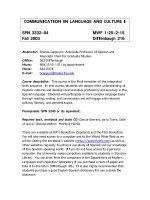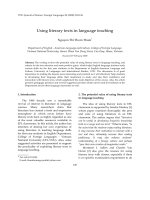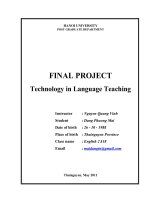CROSSCULTURAL COMMUNICATION IN LANGUAGE TEACHING
Bạn đang xem bản rút gọn của tài liệu. Xem và tải ngay bản đầy đủ của tài liệu tại đây (258.42 KB, 30 trang )
Material on
CROSS-CULTURAL COMMUNICATION IN LANGUAGE
TEACHING
compiled by Phan Thi Kim Loan, M.A.
1
INTRODUCTION
Culture and communication are inseparable because
culture not only dictates who talks to whom, about what,
and how the communication proceeds, it also helps to
determine how people encode messages, the meanings
they have for messages, and the conditions and
circumstances under which various messages may or may
not be sent, noticed, or interpreted... Culture...is the
foundation of communication. (Samovar, Porter, & Jain,
1981)
This Cross-Cultural Communication in Language Teaching course will in
part give you a general overview of the issues newcomers may face when
they live in a foreign country, work in a cross cultural environment or
interact with a new culture: cultural self-awareness, cross-cultural
communication, stereotypes, and values. This course is intended to help
prepare you through a combination of useful information and thought
-provoking exercises.
It’s not possible to talk about culture without making generalizations.
Cultural generalizations are statements of likelihood and potential. At best,
a generalization can tell you how people from a particular culture may
behave in a given situation—not how they will behave or how they will
always behave.
Cultural generalizations can be helpful in the process of learning to
understand other cultures, but be ready to set them aside when it is clear
they have no meaning. Generalizations become dangerous when they
result in negative stereotyping.
2
I. COMMUNICATION, CULTURE, & CROSS-CULTURAL
COMMUNICATION
1. What Is Culture?
For the purpose of this course, here is the way to think about culture:
Culture is a people’s way of life, their design for living, their way of
coping with their biological, physical and social environment. It
consists of learned, patterned assumptions (worldview), concepts
and behavior, plus the resulting artifacts (material goods).
Charles H. Kraft
A major component of a culture is its systems of values, beliefs, and
material products.
First, culture includes belief systems that involve stories, or myths, the
interpretation of which can give people insight into how they should feel,
think, and/or behave. The most prominent systems of beliefs tend to be
those associated with formal religions; however, any system of belief in
which the interpretation of stories affects people’s behaviour—a system of
superstitions, for example—can contribute to a component of a given
society’s culture.
Second, culture includes value systems. Values are formed based on how
we learned to think things ought to be or how people ought to behave,
especially in terms of qualities such as honesty, integrity, and openness.
Third, culture is also defined by material products such as food, clothing,
and music, etc.
Culture is often compared to an iceberg: you can see only a small portion of
it, as most of it is hidden beneath the surface. The tip of the iceberg
represents the visible aspects of culture, such as behaviour, music,
literature, and dress. In this analogy, the remaining huge chunk of ice
3
beneath the surface represents the invisible dimensions of culture, which
include assumptions, values, and beliefs.
Venturing into different cultures without adequate preparation can be just as
dangerous as manoeuvring a ship through icy waters without charts, hoping
to be lucky enough to avoid sharing the same fate as the Titanic!
Observable Features of Culture
(Above)
facial expressions
religious rituals
Invisible Aspects of Culture
(Below)
values
concept of beauty
4
paintings
holiday customs
gestures
foods
eating habits
music
literature
style of dress
concept of fairness
child raising beliefs
understanding of the natural
world
religious beliefs
importance of time
concept of self
concept of leadership
nature of friendship
general world view
work ethic
rules of social etiquette
concept of personal space
notions of modesty
You can see that there is a relationship between those items that appear
above the waterline and those that appear below it. In most cases, the
invisible aspects of culture influence or cause the visible ones. Religious
beliefs, for example, are clearly manifest in certain holiday customs, and
notions of modesty affect styles of dress.
Exercise One
Place each of the following terms in one of the two categories in the table
below, as appropriate.
• Facial expressions
• Gestures
• Literature
• Paintings
• Ideas about leadership
• Democracy
• Ideas about modesty
• Ideas about fairness
• Understanding the natural world
• Foods
• Importance of time
• Concept of self
• Styles of dress
• Concept of beauty
• Rules of etiquette
• General world view
• Gender roles
• Housing
5
• Holiday customs
• Decision making
• Religious beliefs
• Religious rituals
• Values
• Ideas about friendship
• Eating habits
• The importance of work
• Music
• Concept of personal space
• Modes of transportation
• Measures of success
• Folklore
• Slang
• Stereotypes
• Celebrations
Visible
Hidden
By examining hidden culture (i.e., people’s values and beliefs systems) you
will have a better understanding of people’s behaviours and what to make
of them. Not all of us interpret things the same way. For example, in North
America one might say to a colleague or acquaintance, “We should plan on
getting together for a drink next week.” Often this invitation is not followed
through in the following week, and the plan is postponed to the next month.
While this behaviour is considered acceptable in many North American
circles, it is perceived by Danes to be fickle, since Danes typically only
make commitments to social engagements if they intend to follow through
as presented. Be aware that your behaviours may not be interpreted in
another country in the same way as they would be in your home country.
6
Self-Reflection
For each of the following behaviours, write down your interpretation of the
behaviours in terms of your own cultural values, beliefs, or perceptions:
1. A person comes late to a meeting.
2. Someone makes the “okay” hand gesture at you (holding their hand up,
palm facing you, with their thumb and forefinger forming a circle and the
last three fingers held straight up).
3. Someone kicks a dog.
4. Someone in a store says he or she wants to purchase a pair of pants.
In North America the “okay” gesture is used as a way of saying things are
going well, while in many other cultures it can be considered rude or
obscene. In England the word
pants
means “underwear.” People in
England use the word trousers for what in North America is known as
“pants.” Local understandings like these make aspects of living in another
culture tricky. An innocent remark or a gesture on your part can result in a
breakdown in communication. It is easy to know about the material
products of a particular country (e.g., food, music, clothing), but it is more
difficult to figure out what the values and beliefs are, as those are hidden
beneath the surface of the culture.
People from the same culture often share a similar background, which
leads to like perceptions, interpretations, and values. Culture can be
universal—that is, there are ways in which people in all groups are the
same—and it can be personal—that is, there are ways in which each one of
us is different from everyone else. You will find some things in your host
country’s culture to be similar to yours, while other things will be different.
Sometimes, these differences are very subtle. It is your job while accessing
7
another culture to figure out what those differences are.
8
Reading Assignment:
"Culture is the "glue" that binds a group of people together."
(Douglas-Brown- 1994)
"Culture is an elusive construct that shifts constantly over time and
according to who is perceiving and interpreting it."
(Linda Harklau- 1999)
9
"Culture" is a broad concept that embraces all aspects of human life. It
includes everything people learn to do. It is everything humans have
learned. Culture shapes our thoughts and actions, and often does so with
a heavy hand" (Seelye- 1984-1993). Of its several meanings, two are of
major importance to teachers (according to Brooks, 1975*):
Hearthstone or "little-c" culture: Culture as everything in human life
(also called culture BBV: Beliefs, Behavior, and Values)
Olympian or "big-C" Culture: the best in human life restricted to the
elitists (also called culture MLA: great Music, Literature, and Art of
the country).
We should realize that knowing the language, as well as the patterns of
everyday life, is a prerequisite to appreciating the fine arts and literature;
therefore we need a balanced perspective of culture when designing
curricula.
The "big-C" Culture is already taught in the classroom; it is the "little-c" one
that needs to be emphasized, especially in the FL classroom.
According to the US senator, Paul Simon, "Knowledge of the world's
languages and cultures is more vital than ever. In order to compete in the
global community, we must be able to communicate effectively and to
appreciate, understand, and be able to work in the framework of other
cultures." In the past, culture used to be distinct from language; nowadays,
it has become integral to it. If it is important to teach a foreign language to
enhance communication, it is also vital to instill in students an intellectual
and emotional appreciation of the culture of that foreign language, so that
communication will not be impaired.
Dewey (1897) said that "It is true that language is a logical instrument, but
it is fundamentally and primarily a social instrument." If language is
10
"primarily a social instrument," how can it be divorced from the society that
uses it? (Seelye p. 4)
Jay (1968) argued that "Bilingualism is not in itself the answer to cultural
understanding among people... With knowledge of the language must exist
a similar knowledge of the social, religious, and economic attitudes of a
people." (Seelye p. 6)
Learning a language in isolation of its cultural roots prevents one from
becoming socialized into its contextual use. Knowledge of linguistic
structure alone does not carry with it any special insight into the political,
social, religious, or economic system. Or even insight into when you should
talk and when you should not. (Seelye 1993, p 10).
"The study of language cannot be divorced from the study of culture, and
vice-versa (Seelye p. 22).
"A language is part of a culture and culture is part of language; the two are
intricately interwoven so that one cannot separate the two without losing
the significance of either language or culture."
(Douglas-Brown- 1994)
Why language and culture are inseparably connected (Buttjes 1990, p. 55):
(Buttjes, D. (1990). Teaching foreign language and culture: Social impact
and political significance. Language Learning Journal, 2, 53-57.)
1- Language acquisition does not follow a universal sequence, but differs
across cultures;
2- The process of becoming a competent member of society is realized
through exchanges of language in particular social situations;
3- Every society orchestrates the ways in which children participate in
particular situations, and this, in turn, affects the form, the function and the
11
content of children's utterances;
4- Caregivers' primary concern is not with grammatical input, but with the
transmission of sociocultural knowledge;
5- The native learner, in addition to language, acquires also the
paralinguistic patterns and the kinesics of his or her culture. (Buttjes, 1990,
p. 55)
A Conceptual Model of Culture Learning:
Earlier models (Brooks, 1975; Nostrand, 1974) tended to view culture as a
relatively invariate and static entity made up of accumulated, classifiable,
observable, thus eminently teachable and learnable "facts." This
perspective focused on surface level behavior, but did not look at the
underlying value orientations, nor did it recognize the variability of behavior
within the target cultural community, the participative role of the individual
in the creation of culture, or the interaction of language and culture in the
making of meaning (Moore, 1991). By contrast, the more recent models
mentioned above see culture as dynamic and variable, i.e., it is constantly
changing, its members display a great range of behaviors and different
levels of attention to the guiding value orientations, and meaning is
continuously being constructed through human interaction and
communication. This major transformation in perspective has also been
characterized by conceptual shifts from culture-specific to culture-general
models of intercultural competence, cultural stereotypes to cultural
generalizations, cultural absolutes to cultural variations (within and across
cultures), and culture as distinct from language to culture as integral to
12
language. Language in this process plays a fascinating and complex
double role: it is a medium for as well as shaper of culture.
Definition of culture learning:
"Culture learning is the process of acquiring the culture-specific and
culture-general knowledge, skills, and attitudes required for effective
communication and interaction with individuals from other cultures. It is a
dynamic, developmental, and ongoing process which engages the learner
cognitively, behaviorally, and affectively."
Culture learning goals and outcomes:
In this newer perspective, the learning goals shift from the memorization of
cultural facts (including sociolinguistic conventions for language use) to
higher order learning outcomes including: the acquisition of "interactional
competence" (a term suggested by Allen and Moore at the 1996 culture
conference in Minneapolis) and learning how to learn about culture.
According to Paige (1997), such learning would include:
1. learning about the self as a cultural being,
2. learning about culture and its impact on human communication,
behavior, and identity,
3. culture-general learning, i.e., learning about universal, cross-cultural
phenomena such as cultural adjustment,
4. culture-specific learning, i.e., learning about a particular culture,
including its language, and, learning how to learn, i.e., becoming an
effective language and culture learner.
13
THE CULTURAL COMPONENT OF LANGUAGE TEACHING1
Claire Kramsch
The current interest in the role of culture in language teaching is due to a
number of factors, political, educational, ideological. Both in Europe and in
the U.S., albeit for different reasons, there is a great deal of political
pressure now put on foreign language educators to help solve the social
and economic problems of the times. Educators fear that the mere
acquisition of linguistic systems is no guarantee of international peace and
understanding. After years of communicative euphoria, some language
teachers are becoming dissatisfied with purely functional uses of language.
Some
are
pleading
to
supplement
the
traditional
acquisition
of
"communication skills" with some intellectually legitimate, humanistically
oriented, cultural "content". Others, who teach their language to non-native
speaker immigrants, are under pressure to absorb (read: acculturate) into
their society growing numbers of newcomers. And there is of course the
recrudescence (recurrence) of nationalism around the world that draws
political capital from increased links between national languages and
national cultures. The reasons for the growing "culturalisation" of language
teaching are many, the motives often contradictory.
After a short definition of terms, I will first review the history of the
relationship of language and culture in language teaching. I will then try to
survey the current landscape as it relates to various educational traditions
in which languages are taught. In a third part I will suggest a theoretical
base for exploring the cultural component of language study.
Definition of Terms
The term "cultural" has often been associated with the term "social",
as when one talks about the "socio-cultural" factors affecting the
14
teaching and the learning of foreign languages. Many scholars do not
distinguish between the social and the cultural. In this paper, I will take
both adjectives to refer to the two sides of the same coin, namely, the
synchronic and the diachronic context in which language is used in
organised discourse communities. Both terms refer to an individual's place
within a social group and his/her relation to that group in the course of
time. In the words of Adrienne Rich: "A place on the map is also a place in
history" (1986).
First let us agree on a definition. Irrespective of whether we are talking
written or oral culture, highbrow or popular culture, noteworthy events or
events of everyday life, the term "culture" has always referred to at least
two ways of defining a social community. The first definition comes from
the humanities; it focuses on the way a social group represents itself and
others through its material productions, be they works of art, literature,
social institutions, or artifacts of everyday life, and the mechanisms for their
reproduction and preservation through history. The second definition
comes from the social sciences: it refers to what educators like Howard
Nostrand call the "ground of meaning", i.e. the attitudes and beliefs, ways
of thinking, behaving and remembering shared by members of that
community (Nostrand, 1989: 51). This latter definition is in many ways
similar to the one given by social scientists like Richard Brislin in his book
Applied Cross-Cultural Psychology. "Culture", he writes, "refers to widely
shared ideals, values, formation and uses of categories, assumptions
about life, and goal-directed activities that become unconsciously or
subconsciously accepted as "right" and "correct" by people who identify
themselves as members of a society." (Brislin, 1990: 11)
Both definitions have given rise to two different approaches to the study
of culture: the historical and the ethnographic. The first is based on the
15
written tradition of texts; it understands the present and imagines the
future in light of the past; it derives its authority from time-honoured
institutions, gatekeepers of the academy, that have codified the rules of
exegesis (sự bình luận kinh thánh) and interpretation of written texts. The
second is based on the observation, data collection and analysis of
mostly oral phenomena; it understands the present by viewing current
events in the light of their social diversity and their relation to other
contemporary events; it derives its authority from the discovery of laws
that regulate social life. Both approaches give meaning to phenomena by
placing them into appropriate historical and social contexts and by
enunciating (đề ra) their appropriate laws in time and space.
Laws, rules and regularities are not only the fabrication of scientists. They
are constantly generated by people in everyday life. They are what
distinguishes cultural meaningfulness from natural randomness. Because
they allow people to anticipate events, they often acquire a moral rigidity
and righteousness that engender stereotypes and even prejudices. Indeed,
they tend to "naturalise" culture and to make one's own ways of thinking,
speaking and behaving seem as natural as breathing, and the ways of
others seem "unnatural." Culture is always linked to moral values, notions
of good and bad, right and wrong, beautiful and ugly.
But, of course, culture is arbitrary, which doesn't mean it is gratuitous,
only that different events could have been recorded if other people had had
the power to record them, different patterns could have been identified,
these patterns in turn could have been differently enunciated; which is why
culture, in order to be legitimate, has always had to justify itself and cloak
its laws in the mantle of what is "right and just" rather than appear in the
naked power of its arbitrariness.
16
Teaching culture means therefore teaching not only how things are and
have been, but how they could have been or how else they could be.
Neither history nor ethnography provide this imaginative leap that will
enable learners to imagine cultures different from their own. Breaking down
stereotypes is not just realising that people are not the way one thought
they were, or that deep down "we are all the same". It is understanding that
we are irreducibly unique and different, and that I could have been you,
you could have been me, given different circumstances — in other words,
that the stranger, as Kristeva says, is in us. In addition to history and
social science, culture is therefore also literature, for it is literature that
opens up "reality beyond realism" and that enables readers to live other
lives — by proxy.
Culture, then, constitutes itself along three axes: the diachronic axis of
time, the synchronic axis of space, and the metaphoric axis of the
imagination. But to what extent is culture in that sense the responsibility of
the language teacher?
One of the major ways in which culture manifests itself is through
language. Material culture is constantly mediated, interpreted and
recorded — among other things —through language. It is because of that
mediatory role of language that culture becomes the concern of the
language teacher. Culture in the final analysis is always linguistically
mediated membership into a discourse community, that is both real and
imagined. Language plays a crucial role not only in the construction
of culture, but also in the emergence of cultural change. To be sure,
the optimism of the sixties and early seventies concerning the possibility of
changing people's attitudes by giving them a new vocabulary to construct
social realities (whether they be national, gendered, or racial realities) have
given way to a much more sober assessment of language teachers' limited
17
room for manoeuvre against more powerful institutional ideological forces
(Fairclough, 1989). However, this power is not monolithic and education
has never brought about change directly and immediately. Social change
occurs slowly, but inevitably at the edges of dominant cultures. This is true
also of the change that we might want to bring about by teaching people
how to use somebody else's linguistic code in somebody else's cultural
context. Teaching members of one community how to talk and how to
behave in the context of another discourse community potentially changes
the social and cultural equation of both communities, by subtly diversifying
mainstream cultures.
This view of the social construction of culture through language has been
researched by sociolinguists and by scholars in the general field of cultural
studies. However, it is not a view that is familiar to language teachers, who
tend to consider culture as composed of attitudes and ideas existing
somewhere out there independent of language.
Historical Background
Throughout the history of language teaching, we can distinguish three
types of links between language instruction and the teaching of
culture: universal, national, and local links.
Universal links between language and culture
In the days when the only academically respectable languages taught
were Latin, classical Greek or Hebrew, there was no question but that a
certain universal "culture" was acquired together with and through the
knowledge of the absolute ablatives (cách công cụ) and the conjugation of
the aorist (thời bất định). Roman and Greek history was not usually taught
within the language curriculum and the translation of De Bello Gallico
rarely gave students an understanding of the ways Roman actually spoke
18
and thought; yet, nine years of Latin were the best entrance ticket to the
universal culture of the European educated elite. The sacred truths might
have been replaced by more secular ones, but the link between language
study and culture was an immediate and uncontested one.
For all modern languages the way to universality was through their
literature. We all know how up until recently, the sole rationale for the
teaching of modern languages was access to the "great works", the
universal canon of world literatures. Literature, like the Holy Scriptures or
Cicero's oratories, ensured a certain cosmopolitan, at first religious, then
aesthetic, view of the world that various speakers of various languages
could share across social and national boundaries. Translations and
explications de textes ensured exquisite attention to shades of textual
meaning that were neatly enclosed within their own worlds of semantic
reference.
National links between language and culture
With the development of literary criticism beyond philological inquiry, and
the growth of linguistics as a field in its own right, the split between the
teaching of language and the teaching of literate culture widened.
Language acquisition became the acquisition of skills, of automatic verbal
behaviours that were perceived as having no cultural value in themselves,
but that could later give access to a national literature with unique cultural
value.
Within this national perspective, not only did language teaching get
separated from the teaching of literature, it got separated from the teaching
of
culture
as
well.
Subjects
like
French
"civilisation",
German
"Landeskunde", English "culture" have developed separately from
language instruction, enclosed in textbooks within culture capsules, cultural
notes, glossy photographs and more recently a array of so-called authentic
19
texts.
The
German
1989
encyclopaedic
Handbuch
Fremdsprachenunterricht (Bausch et al., 1989) lists the following
disciplines as informing elements of language teaching: applied linguistics,
psycholinguistics, sociolinguistics, education, learning theory, literary
studies and, in a separate category, "Kultur- und Landeswissenschaft" or
study of the land. Indeed, the classification gives the impression that
language is the mere conduit for transmission of a literary or cultural
knowledge that exists out there independent of the discourse in which it is
cast.
In the last 30 or 40 years, the academic separation in the teaching of
culture, literature and language has allowed each domain to make the
theoretical and pedagogical advances we know, but it has caused
language teaching to lose sight of the crucial factor I mentioned
earlier: namely, the mediating function of language in the social
construction of culture. The separation has kept language teaching within
strict structural or functional bounds, with culture often considered to be a
fifth skill, after speaking, listening, reading and writing.
Local links between language and culture
In the 70s, language teaching was no longer in the exclusive service of the
educated elite, but was made to serve more democratic social goals. It
was to meet the local needs of local speakers and hearers in locally
situated contexts of communication. The cultural component of language
teaching came to be seen as the pragmatic functions and notions
expressed through language in everyday ways of speaking and acting.
This understanding of culture as the words and actions of everyday
speakers in everyday life brought into focus the synchronic axis of
language use. It did stress particular situations and local transactions
between friends and acquaintances, vendors and consumers, employers
20
and employees. But it was predicated on a kind of universality based on
shared human needs, easily expressed, interpreted and negotiated
through universal speech functions. Since then, linguists doing research in
the realisation of speech acts across cultures have come to understand
how illusory this universality is (e.g., Blum-Kulka, House & Kasper, 1989).
Others have shown how imperialistic even a pragmatic approach to
teaching language can be if it assumes that universally shared basic
human needs automatically correspond to universally shared ways of
thinking and talking about those needs (Phillipson, 1992).
Current Landscape
The teaching of culture as a component of language teaching has
traditionally been caught between the striving for universality and the
desire to maintain cultural particularity. By nature it grapples with the
following dilemma: should it stress the commonalities or emphasize the
differences between the native and the target culture? To what extent must
teachers hold non-native speakers to native speakers' conventions of
language use, and to native speakers' norms of interpretation?
The current landscape is dominated by two catchwords, which have each
unleashed political passions on either side of the Atlantic: "intercultural"
and "multicultural". These words characterise two educational attempts to
understand and overcome particularity, by building bridges between one
culture and another. The term "intercultural" is used in Europe in the
educational world, to characterise the acquisition of information about
the customs, institutions and history of a society other than one's own;
in the corporate world, the term is applied to the behavioural training for
business executives (e.g. Müller & Thomas, 1991; Müller, 1991).
Beyond the traditional knowledge of cultural facts, an intercultural
approach aims at gaining an understanding of the way these facts are
21
related, i.e. how as a pattern they form the cultural fabric of a society.
Examples of this approach can be found in attempts to develop
intercultural sensitivity in the training of language teachers (Baumgratz,
1992; Baumgratz & Stephan, 1987), or in the international dialogue
proposed by Robert Picht (1989), or in the "intercultural communicative
competence" advocated by Michael Byram (1993: 16). Other forms of
intercultural education refer to a process of decentering, of relativising
self and other in an effort to understand both on their own terms and from
their own perspective, as well as from the outsider's perspective. This
"intercultural approach" to teaching foreign languages (Zarate, 1986, 1993)
and to writing foreign language textbooks is not without raising some
controversy among politicians and literary scholars alike who feel that
language teachers should be responsible for teaching "only language", not
culture nor politics. Indeed, culture cannot and should not be taught in
classrooms, they say, but rather, learners should be sent abroad to
experience the culture "on location". Educational and applied linguistics
research has picked up the challenge, and is trying to precisely document
and evaluate the cultural component of study abroad programs (see
Brecht, Davidson & Ginsberg, 1993; Kline, 1992) or the cultural gains
made by pupils in linguistic exchange programs within the European
Community.
2
Findings seem to indicate that sojourns abroad,
destined to enhance linguistic proficiency, do not ensure per se
deeper cross-cultural understanding.
Radically different from these efforts to link the teaching of foreign
language to an understanding of foreign national cultures are current
initiatives in American foreign language education to broaden and diversify
traditional views of culture beyond the boundaries of nation states. The
notion of "multicultural education", in particular, attempts to "expand the
22
traditional curriculum by incorporating issues of race, class, and gender in
an effort to sensitise students to the unique historical realities that have
shaped United States culture" (Mullen, 1992). Multiculturalism has had the
effect of de-emphasising national differences and of highlighting the social
diversity and cultural pluralism that exists within one and the same nation,
within one and the same foreign language classroom due to differences in
ethnicity, social class and gender (Taylor, 1992).
It is little wonder that multiculturalism has become in the U.S. the target of
hot political debates; right wing factions accuse multiculturalist liberals of
"political correctness", left-wing liberals accuse the right of chauvinist
intolerance. The debate is fuelled by current discussions about immigration
laws in the light of the recent immigration waves, both legal and illegal, to
the
United
States.
From
the
language
teacher's
perspective,
multiculturalism has helped diversify the presentation of foreign cultural
phenomena to include a variety of social class and ethnic groups.
Unfortunately, the traditional national isolationism of American education
counteracts the benefits of its multicultural perspective. Cultural diversity
within the United States is of such overwhelming concern in American
education that one easily loses sight of general national characteristics that
might differentiate U.S. Americans from citizens from other countries. It is
easy to take one's own national culture for universally human. Under the
fear of reinforcing cultural stereotypes, and under the cover of multicultural
pluralism, the default assumptions linked to national cultural ideologies
remain often unquestioned and, hence, unexplored.
In sum: Despite the advances made by research in the spheres of the
intercultural and the multicultural, language teaching is still operating on a
relatively narrow conception of both language and culture. Language
continues to be taught as a fixed system of formal structures and universal
23
speech functions, a neutral conduit (ống dẫn) for the transmission of
cultural knowledge. Culture is incorporated only to the extent that it
reinforces and enriches, not that it puts in question, traditional boundaries
of self and other. In practice, teachers teach language and culture, or
culture in language, but not language as culture.
Theoretical Base for an Understanding of Culture in Language
Teaching
Recent suggestions have been made to bring language teaching more in
line with current thought in both the linguistic and in the social and critical
sciences (Fairclough, 1989; Kramsch, 1993a and b; Pennycook, 1990;
Byram, 1989, Byram et al., 1991; Kramsch & von Hoene, 1995; Kramsch &
Nolden, 1994). The argument goes as follows.
If we accept, with Halliday (1978), that language "as social semiotic" is
central to the way cultural reality is shaped and represented, then we have
to realise that cultural reality is as heterogeneous and heteroglossic
as language itself. What does it mean to say: "French speak this way,
Israelis think that way, Russians behave that way?" Cultural characteristics
are embedded within historical relations of power and authority which
secure social, professional, political, pedagogical status through the way of
speaking of particular speakers in a particular time and from a particular
space. Multicultural relativism or democratic pluralism do not automatically
reverse these relations of power and authority, they only make them more
invisible. This is where advocates of critical language pedagogy propose
replacing the binarism (nhị phân) of Us vs. Them, Insider vs. Outsider, that
essentialises people in one or the other of their many cultural dimensions
(e.g., an "Israeli" or a "woman", or a "Black") by a focus on what Bhabha
calls the "social process of enunciation" (Bhabha, 1992: 57).
24
This process is a dialogic process that attempts to locate the cultural
component of language teaching at the moment of rupture or disjuncture
between interlocutors' assumptions and expectations. A critical foreign
language pedagogy focused on the social process of enunciation has
the potential both of revealing the codes under which speakers in crosscultural encounters operate, and of constructing something different and
hybrid from these cross-cultural encounters. Bhabha calls this "a third
space, that does not simply revise or invert the dualities, but revalues the
ideological bases of division and difference" (Bhabha, 1992: 58). Rather
than seek to bridge differences and aim for the universal, it seeks to create
a dialogic context in which the vital necessity to continue the dialogue
ensures a mutual base to explore the sometimes irreducible
differences between people's values and attitudes.
Of course, it is Third World or minority cultures that have given us the
necessary insights in this regard. Homi Bhabha, writing about "Postcolonial
authority and postmodern guilt" (1992), describes well the situation of the
language teacher having to teach in conditions of heteroglossia: "From that
perspective, the perspective of the 'edge' rather than the end, it is no
longer adequate to think or write culture from the point of view of the liberal
'ethic' of tolerance, or within the pluralistic time frame of multiculturalism".
Culture must be seen as a moment caught "in between a plurality of
practices that are different and yet must occupy the same space of
adjucation and articulation" (p. 57). The realisation of cross-cultural
conflict and incommensurability of values offers the opportunity to
pause and muster the effort necessary to speak, quite literally, in
terms of the other. Bhabha calls this pause "the time-lag of cultural
difference" (p. 64), "an interrogative space ... of psychic ambivalence and
social contingency" (p. 59). For Bhabha, this ambivalence is grounded in
25









